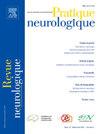Étude électroneuromyographique du nerf médian : explorer le canal carpien sans s’égarer en chemin
Q4 Medicine
引用次数: 0
Abstract
Le nerf médian est sans doute le nerf le plus exploré en électroneuromyographie, étant donné la fréquence de son atteinte au canal carpien. Après un rappel des points clés de l’anatomie du nerf médian, nous présentons les techniques d’exploration du syndrome du canal carpien ainsi que la problématique des variations anatomiques, indispensables à garder à l’esprit dans toute exploration du nerf médian. L’étude des atteintes plus proximales du nerf médian nécessite de bien connaître l’anatomie et le trajet du nerf médian, pour identifier le lieu de la lésion par la clinique et l’ENMG. Enfin, bien rédiger le compte rendu d’un électromyogramme explorant le nerf médian est fondamental compte tenu des enjeux thérapeutiques, notamment chirurgicaux, qui en découlent.
The median nerve is undoubtedly the most frequently examined nerve in electromyography due to the high prevalence of its entrapment at the carpal tunnel. In this article, we make a short review of the key points of its anatomy, we present the techniques for investigating carpal tunnel syndrome, as well as the issue of anatomical variations, which must always be considered during any median nerve exploration. Identifying lesions of the median nerve at locations proximal to the carpal tunnel, requires good understanding of median nerve anatomy, in order to localize the site of injury, using clinical and electrophysiological markers. Finally, drafting a well-structured electromyography report on median nerve assessment is essential, given the therapeutic implications, particularly surgical ones, that may arise.
中神经的电子神经造影研究:探索腕管而不迷失方向
中神经可能是电子神经造影中研究最多的神经,因为它攻击腕管的频率。在回顾了中脉解剖学的要点之后,我们将介绍探索腕管综合征的技术,以及在探索中脉时必须考虑的解剖变化问题。近端中神经病变的研究需要对中神经的解剖结构和路径有很好的了解,以便诊所和ENMG能够确定病变的位置。最后,考虑到由此产生的治疗问题,特别是外科问题,写一份探索中线神经的电泳报告是至关重要的。毫无疑问,中神经是电泳中检查最频繁的神经,因为它的夹板在腕部隧道中非常普遍。在这篇文章中,我们简要回顾了其解剖学的关键点,我们介绍了调查腕管综合征的技术,以及解剖变异的问题,这是在任何中层神经探索中都必须考虑的问题。使用临床和电生理标记,识别靠近腕管位置的中神经损伤需要对中神经解剖学有良好的了解,以便定位损伤部位。最后,考虑到可能出现的治疗意义,特别是外科意义,起草一份关于中层神经评估的结构良好的电泳报告是至关重要的。
本文章由计算机程序翻译,如有差异,请以英文原文为准。
求助全文
约1分钟内获得全文
求助全文

 求助内容:
求助内容: 应助结果提醒方式:
应助结果提醒方式:


